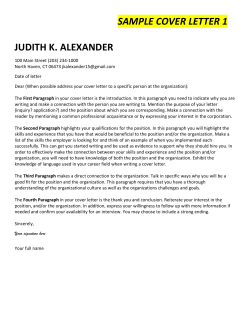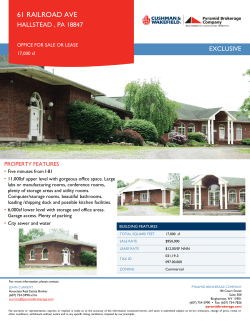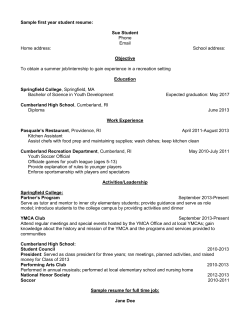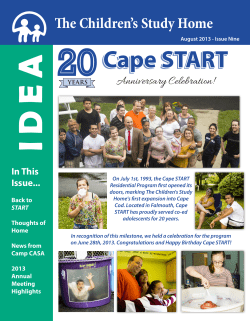
Manual
Virtual New Haven Railroad
Manual
Virtual New Haven Railroad
SPRINGFIELD LINE for Train Simulator 2014
Version 1.0: Springfield to Windsor Locks
Virtual New Haven Railroad
Manual
Contents
1)
Introduction
p. 3
2)
System Requirements and Installation
p. 4
3)
The Route in Detail
p. 4
4)
1. Overview Map
p. 5
2. Yard Detail Maps
p. 6
3. Towns and Industries
p. 8
Equipment
1. Engines
◦ Operating the Train Brakes
p. 16
p. 16
p. 17
2. Freight Cars and Non-Revenue Equipment
p. 18
3. Passenger Cars
p. 20
5)
Credits and Acknowledgements
p. 21
6)
Support and Copyright Information
p. 22
Virtual New Haven Railroad
Manual
Introduction
About the Virtual New Haven Railroad
Welcome to the Virtual New Haven Railroad! The "VNHRR" is a project for the
Train Simulator 2014 computer game, our aim is to model the New Haven
Railroad's Springfield Line, from Springfield, MA, to New Haven, CT, as it
appeared in the mid-20th century. The 1950s were the last of the New Haven
Railroad's glory days, and we are trying our best to make you feel like you are
really there in that special era in railroading history.
The route is being developed in three or more phases, the first of which covers
the New Haven mainline from the line's terminus at Springfield, MA, to the town
of Windsor Locks, CT. The branch line to Suffield, CT, and the Windsor Locks
International Airport is also included.
Plenty of rolling stock is included with the route, you can run two ALCO work
horses, graciously supplied by Dick Cowen and Mannu Pach, and pull many
custom built freight cars of the period. Hundreds of custom assets accompany the
route, from small clutter items to entire town blocks.
While the route's main focus is clearly on the New Haven Railroad, some trackage
of the Boston & Albany (New York Central System) and Boston & Maine
railroads is included too, these three roads met in Springfield and regularly
interchanged cars.
We hope you will enjoy this little trip back in time, on a unique railroad that
despite its several bankruptcies and questionable management decisions we
regard as one of the true industrial icons of the Northeastern U.S.
Virtual New Haven Railroad
Manual
System Requirements
You need a full installation of Train Simulator 2014 to use this add-on and your
PC should meet the minimum requirements of the base game.
Ownership of the European and the U.S. Community Assets Packs is required as
well. It is likely that you already have them installed if you own other DLC
routes, please visit the Steam Store pages linked below for more details.
U.S. Community Assets: http://store.steampowered.com/app/208306/
European Community Assets: http://store.steampowered.com/app/208300/
Installation
The VNHRR Springfield Line is available through a standalone installer.
•
•
•
•
•
Download your product using the download link provided in your eMail
Unzip the .zip-file into a place where you can easily access it. We recommend unzipping it to your
desktop.
Double-click the unzipped .exe-file provided with your download.
Choose your language for the installation. The language setting you use here is not affecting the
language settings of the scenarios or Trainsimulator 2014, this selection is only valid for the
installation process itself.
Follow the instructions of the installation program.
After launching the game, you can run the route either by selecting it in the
QuickDrive menu, or by selecting one of the Free Roam or Standard Scenarios for
it in the Drive menu.
If you ever need to uninstall the VNHRR Springfield Line, please follow these
instructions:
• Click on the Windows Button in your taskbar
•
•
•
Choose: All Programs
Select the Trains and Drivers folder
Click on the uninstaller-icon of the product you want to deinstall.
Virtual New Haven Railroad
Manual
The Route in Detail: Overview Map
Virtual New Haven Railroad
Manual
Yard Detail Maps
West Springfield B&A Yard
Virtual New Haven Railroad
Manual
Springfield NH Yard
Virtual New Haven Railroad
Manual
Towns and Industries along the Route
Springfield: Industry and Innovation
The Connecticut River Valley played a key role in the Industrial Revolution that
changed economic and social life in the United States during the nineteenth
century. The river itself served as a transportation and communication link for
the earliest human settlements, and later provided power to run mills and
factories. The Springfield Armory attracted skilled craftsmen and engineers, and
was the site of crucial technological improvements in armaments, machinery,
and metalwork. Smith & Wesson, Springfield Rifles, etc.
Springfield is the hub of the VNHRR Springfield route. Three railroads meet here,
the Boston & Albany's mainline to Boston and Albany, the Boston & Maine's line
to Greenfield, and the New Haven's Springfield line to New Haven. Local
Passenger trains ran on all three railroads, in addition you can board express
Virtual New Haven Railroad
Manual
services on the B&A (to Boston and Albany) or on the NH to travel to New York
City via New Haven. The Railroads made Springfield a regional hub of industry
and innovation, in everything from ice skates to automobiles including the
legendary Indian Motorcycle.
West Springfield
The town of West Springfield is marked by the huge classification yard of the B&A
railroad that cuts the town in half. It is quite an interesting yard, built along a
curve and with east- and westbound yards seperated by the double track
mainline, giving you the opportunity to run some pretty challenging yard
switching tasks.
To the north of the yard is a big double roundhouse, a medium sized engine and
repair shops, and several industries. A short branch line to the south of the yard
takes you to the Springfield Exposition Grounds and the West Springfield power
plant, originally a coal-fired plant that primarily operates to assist with energy
geenration during the hours of peak demand.
Virtual New Haven Railroad
Manual
Thompsonville: Carpet Manufacturing
Thompsonville is a small town a few miles south of Springfield. Local New Haven
– Springfield passenger trains stop at Thompsonville and a team track and a
freight house spur can be found next to the depot on both sides of the mainline.
Its most noteworthy feature for our route is the large Bigelow-Sanford Carpet
Company, with its several cargo tracks and even its own small powerplant.
North and south of Thompsonville are two passing sidings, one for each
direction. The northbound passing track can also be used as a drill track to
switch the carpet factory's tracks.
The carpet industry in Enfield was started by Orrin Thompson in 1828. Early
production consisted mostly of inexpensive flat-woven ingrain carpeting. As the
mill became established other more expensive weaves were added. By 1846 there
were 230 looms in operation at the mill. By 1850 carpet output from the
Virtual New Haven Railroad
Manual
Thompsonville mills had reached 250,000 yards per year and by 1871 the mill
was producing over 7,000 yards of carpeting per day.
400,000 square feet of buildings were added in 1901, including a 900 foot long
tapestry mill, a worsted mill, finishing, fulling, and scouring mills, a color house,
and a rug finishing department. In 1902 an axminster mill was added, as were
new broad looms and a 4,000 horsepower electric plant. By 1910 there were
2,900 employees turning out 7.5 million yards of carpet per year.
Profits remained good and a merger took place with the Sanford Carpet Company
of Amsterdam, New York. The newly formed Bigelow-Sanford Carpet Company,
Inc. was hit hard by the depression, but was able to recover and was again
issuing dividends by 1935.
During World War II production turned to materials and equipment for the war
effort, $56 million in blankets, more than any other manufacturer. Also,
enormous quantities of duck and rubber coated nylon and rayon for tires. The
mill's machine shops produced parts for submarines, planes, radar, and Oak
Ridge.
The post-war boom brought total employment to 9,000 in 1948. However,
production was gradually shifted to more modern, less expensive to operate,
southern factories. Despite years of attempts by local management to make the
plant productive enough to be profitable, the mill closed in 1971 and was vacated
by the next year.
Today, most of the original structures have been razed and what few remain have
been repurposed as condominiums.
Virtual New Haven Railroad
Manual
Warehouse Point
The railroad station at Warehouse Point is about a mile north of the actual town,
which is located on the east bank of the Connecticut River just opposite of
Windsor Locks. There are only a small factory and a few team tracks left at the
former station of Warehouse Point and they only get infrequent service.
The first English settler in what is today known as East Windsor, was William
Pynchon, the founder of Springfield, Massachusetts. In 1636, he erected a
warehouse for his settlement's transshipment of goods at what is, to this day,
known as "Warehouse Point".
Pynchon selected the site of Warehouse Point because of its location near the
Enfield Falls — the first major falls in the Connecticut River, where all seagoing
vessels were forced to terminate their voyages, and then transship to smaller
vessels. By constructing a warehouse at Warehouse Point, Pynchon essentially
forced all northern Connecticut River business to run through him and his
settlement at Springfield, Massachusetts.
Virtual New Haven Railroad
Manual
Windsor Locks: Small Town, Big Business
Windsor Locks is a small industrial town on the west bank of the Connecticut
River and just south of the New Haven's Suffield Spur. At Windsor Locks you can
find the typical depot and freight house combination, accompanied by the small
yard utilized by the Montgomery and Dexter companies. The yard is set in an
unusual environment, between the one-sided main street on the west side and
the mainline, canal, multi storied mills and factories to the east.
The J. R. Montgomery & Co. was established in 1871, for the purpose of
manufacturing cotton warps used in satinets, a finely woven fabric with a finish
resembling satin but made partly or wholly from cotton. And cassimeres, a
closely woven smooth twilled usually wool fabric (as for suits).
In the 1890s, the company began producing tinsel products, eventually becoming
the country’s largest manufacturer of decorative and electric tinsels.
Virtual New Haven Railroad
Manual
The Dexter paper mill is one of the oldest landmarks of Windsor Locks, the
business dates back over 100 years. In 1840 a mill for the exclusive purpose of
manufacturing paper was erected on the river side of the canal. The nucleus of
the present plant was built in 1876, after the original mill had been destroyed by
fire.
Just north of the Suffield Spur Junction are two short storage and switching
sidings, one on each mainline track.
Suffield and the Suffield Spur
Located at one end of the branchline ("spur" in New Haven terminology) that
carries its name, the town of Suffield does not generate much traffic. The primary
business around here is agriculture, and more precisely shade-grown tobacco –
Virtual New Haven Railroad
Manual
which is what all those long, flat tents along the line are for. The tobacco is
grown under the shade of the tents, then dried in the long tobacco barns, and
finally shipped out to be used as cigar wrapping. Connecticut River Valley shade
grown tobacco is considered to be some of the best cigar wrap in the world.
The other end of the Suffield Spur is much busier in terms of railroad traffic:
Bradley Field, originally named ‘Windsor Locks Army Air Base’. In 1941 it was
renamed ‘Army Air Base, Bradley Field’ after Lt. Eugene Bradley was killed in a
‘dogfight’ training exercise above the field. The facility became locally know as
Bradley Field when the govornment returned the facility to the State of
Connecticut for civil operation in 1946. Today it is known as Bradley
International Airport (BDL). The facility then and now requires aircraft fuel, oil,
and various other goods that get handled at the airport warehouses.
Situated at the far end of the Bradley Field Spur is the Hamilton Standard
Propeller Corporation, which back in the days our route is set in was a leading
US manufacturer of aircraft propellers. Their oval logo is often seen on most
propellers of the time. Later, Hamilton Standard, along with ILC (a marriage
made at NASA), went on to become instrumental in developing the space suits
worn on the Apollo moon missions.
Today known as Hamilton-Sustrund, a leader in Areo-Space Technology and still
a division of East Hartford based United Technologies (Pratt & Whitney Aircraft
(engines), Carrier (climate control), Otis Elevator, Sikorsky Aircraft
(helicopters).
Virtual New Haven Railroad
Manual
Equipment: Engines
ALCo FA/B-1 (NH Class DER-2a)
VNH ALCO FA-1 NH
VNH ALCO FB-1 NH
These powerful ALCo hood units were the mainline work horses of the New
Haven railroad. Pulling mostly heavy freight trains of all sorts, these engines
could be seen all over the NH's network. The models of the A- und B-units
included with the VNHRR Springfield Line have were built by Cesar Pach and are
available in the red and black Trustee paint scheme.
ALCo RS-3 (NH Class DERS-2c)
VNH RS3 McGinnis1
VNH RS3 McGinnis2
VNH RS3 old
As a road switcher, these elegant engines proved versatile and enduring,
performing all kinds of work like switching duties, branchline work or local
freight runs. Being equipped with steam boilers, the RS3 could also be seen in
local and commuter passenger service all year around. Three models of the RS-3,
all built by Dick Cowen, are included with the VNHRR Springfield Line. You can
Virtual New Haven Railroad
Manual
run them in the old simplified green and orange paint scheme and two McGinnis
paint schemes.
Operating the Train Brakes
All engines included with the VNHRR Springfield Line are equipped with a
simplified model of 24RL Brake Valves. In contrast to the brakes you are used to
from the modern U.S. diesel engines in the game, these are not self-lapping. To
operate them properly, you must handle them more like the train brakes on a
steam engine.
To apply the train brakes, move the handle from the Release or Running position
to the Apply position. Watch the brake pipe pressure readouts, once you have
reached the desired brake force, pull the brake lever back to the Lap position.
The brake pipe pressure will now be maintained at the current level. Should you
need more brake force, move the lever back to Apply, wait until the desired brake
pipe pressure has been reached, then move it back to Lap.
To release the brakes, pull the lever back towards you, to the Release position.
On the extreme right end of the lever's way of travel is the Neutral Handle Off
position (in which nothing happens to the brakes but a real engineer could
disconnect the lever handle), pushing the lever beyond it you go into Emergency.
Hint: you can control the speed of the brakes application quite delicately with
this brake valve: move the lever only a little into the Apply position and the
pressure will drop only slowly, which can very useful for setting the brakes to
maintain speed on gentle descents. To apply the brakes more quickly, simply
move the lever all the way towards the end of the Apply position, just before it
reaches the Neutral Handle Off position.
Virtual New Haven Railroad
Manual
Freight Cars and Non-Revenue Equipment
Boxcars
VNH 40ft Box PS-1 BM1
VNH 40ft Box PS-1 BM2
VNH 40ft Box PS-1 BM3
VNH 40ft Box PS-1 BM1
VNH 40ft Box PS-1 brown 1
VNH 40ft Box PS-1 brown 2
VNH 40ft Box PS-1 brown 3
VNH 40ft Box PS-1 McG 1
VNH 40ft Box PS-1 McG 2
VNH 40ft Boxcar DS1
VNH 40ft Boxcar DS2
VNH 40ft Reefer
Virtual New Haven Railroad
Manual
Gondolas
VNH Gondola 43ft
VNH Gondola BM
Flatcars
VNH Flatcar
VNH TOFC
Hoppers
VNH Hopper 55t
Tankcars
VNH Tankcar
VNH Hopper 55t
VNH Hopper 70t
Virtual New Haven Railroad
Manual
Cabooses
VNH Caboose NE-5 BM
VNH Caboose NE-5 McG1
VNH Caboose NE-5 red
Passenger Cars
VNH Pullman Coach green
VNH Pullman Coach McGinnis
VNH Caboose NE-5 McG2
Virtual New Haven Railroad
Manual
Credits and Acknowledgements
Contributors
•
Bob Jones: Original Concept and Idea, Scenery and Rolling Stock Modeling,
Route Building, Scenario Design
•
Michael Stephan: Scenery and Rolling Stock Modeling, Route Building,
Scenario Design, Packaging
•
Phil Moberg: Technical and Historical Advice, Rolling Stock Modeling,
Testing
•
Andreas Czudai: Publishing, Advice and Testing
•
Dick Cowen: ALCO RS3 Models
•
Mannu Pach: ALCO FA/B-1 Models
•
Thomas Pearce: Fruehauf Trailers, Passenger Car parts, Advice and Testing
•
Rick Grout: Freight Car Sounds, Many Tips and Tricks, Testing
•
Richard Carter, Tom Pallen, Matt Peddlesden: Advice and Testing
Other Credits
•
CGTextures.com: image files used on textures
"One or more textures on this 3D model have been created with images from
CGTextures.com. These images may not be redistributed by default, please visit
www.cgtextures.com for more information."
•
MediaCollege.com: additional sound files used on rolling stock
Virtual New Haven Railroad
Manual
Support and Copyright Information
Copyright, Repaints, Distribution, Warranty:
All of the contents of this software are copyrighted material and may not be
further distributed or reused, whole or in part, without express written
permission by the authors and publishers, Bob Jones and Michael Stephan.
You can do repaints of the included models for your own, personal use, but are
not allowed to distribute them with the geometry files included with your
repaint. If you wish to publish your repaints you need the express written
permission of the original authors.
This software is provided to you on an “as is” basis without any express or
implied warranty of any kind, including but not limited to any warranties of
merchantability, noninfringement, or fitness of a particular purpose.
Support & Contact Information:
Please visit vnhrr.golden-age-rails.com for more information, or write an email to
vnhrr@golden-age-rails.com.
A Word from Railsimulator.com:
"IMPORTANT NOTICE. This is user generated content designed for use with
RailSimulator.com Limited’s train simulation products, including RailWorks 5:
Train Simulator 2014.
RailSimulator.com Limited does not approve or endorse this user generated
Virtual New Haven Railroad
Manual
content and does not accept any liability or responsibility regarding it.
This user generated content has not been screened or tested by
RailSimulator.com Limited. Accordingly, it may adversely affect your use of
RailSimulator.com’s products. If you install this user generated content and it
infringes the rules regarding user-generated content, RailSimulator.com Limited
may choose to discontinue any support for that product which they may
otherwise have provided.
The RailWorks EULA sets out in detail how user generated content may be used,
which you can review further here: www.railsimulator.com/terms. In particular,
this user generated content includes work which remains the intellectual
property of RailSimulator.com Limited and which may not be rented, leased, sublicensed, modified, adapted, copied, reproduced or redistributed without the
permission of RailSimulator.com Limited."
© Copyright 2025









